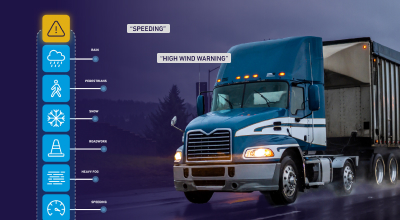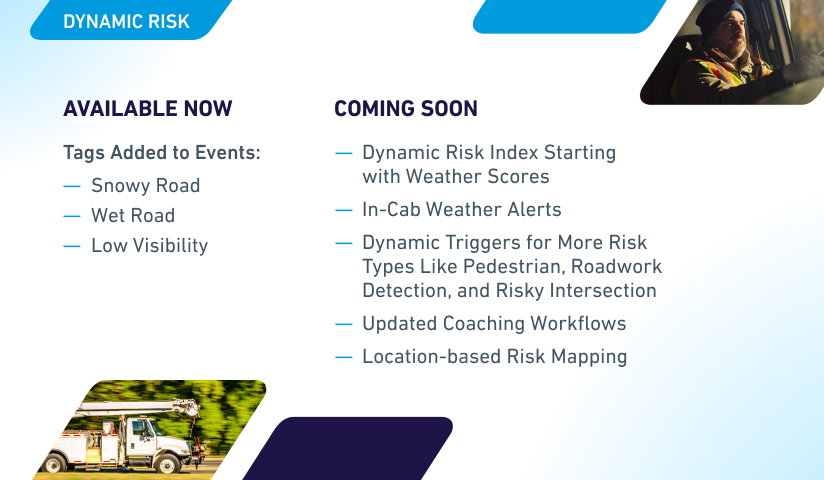What is Dynamic Risk? And What’s Coming Next? Your Questions, Answered

Dynamic Risk from Lytx® is here. Read on to learn what it means, why it matters, and what the future of the solution will look like.
Why focus on Dynamic Risk?
Road conditions are unpredictable. You can never really be completely prepared or able to foresee much of the risk that happens at any given moment. Fleets can get a general understanding of what the weather will be like or where construction will occur that day. But do they really know when an unsuspecting pedestrian is going to cross the street? Or when there will be an accident that will back traffic up and cause mayhem?
Risk stacks and escalates fast—weather, road users, and conditions combine unpredictably and dangerously. Drivers need dynamic guidance that accounts for real-time, local context, not generic or outdated warnings. And fleets need proactive solutions to keep their drivers safe, reduce liability, and boost uptime.
When fleets use Dynamic Risk, an innovative set of features, they can confidently master every mile and proactively navigate through intensified, real-world situational and environmental events that add a level of severity to the additional layer of risk identified.
How has Lytx technology adapted to meet these needs?
Lytx has been developing Dynamic Risk in the Lytx Lab for over two years. The Lytx Lab is a collaborative environment where Lytx teams, safety experts, and customers come together to innovate, test, validate, and optimize product ideas before they are rolled out to the broader market. Our technology now allows for real-time data from over a million vehicles and regional weather databases to be leveraged instantly. In addition to weather information, contextual data for more risk types like pedestrian, roadwork detection, and risky intersections will soon be available.
What is Lytx’s Dynamic Risk solution?
Lytx’s extensive network of cloud-connected cameras combined with our powerful MV+AI technology enables us to analyze road-view imagery and create highly localized hazardous alerts for adverse weather, pedestrian, roadwork detection, and risky intersections to help fleets anticipate potential risks and proactively prevent incidents. These real-world conditions give fleets the ability to enable timely, in-cab alerts that are context-aware and adaptive.
Dynamic Risk will be rolled out in several feature releases. Explore more below.
What can you expect from Dynamic Risk?

Available now:
Snowy Road, Wet Road, Low Visibility Tags Added to Events
Enhance risk visibility through automated Event tagging of environmental snowy road, wet road, and low visibility conditions. Managers can use this information to identify patterns and severity levels of risk to boost their coaching efforts and enhance their effectiveness.
Why this adds value to your fleet
- This results in fairer, more reliable assessments that build trust with drivers and make coaching more effective.
Available globally for Lytx DriveCam® SF-300 and newer devices.
Real-world example
- A lane departure during heavy rain is marked Wet Road, helping distinguish between risky behavior and weather-driven conditions.
Coming Soon:
DECEMBER: Dynamic Risk Index Starting with Weather Scores
This new scoring model will be fully integrated into existing coaching workflows. This weighted score will be based on risk modeling that layers on top of the existing behavior score. This score will dynamically adjust based on the severity of the behavior and environmental context and powered by data science to reflect real-world risk.
Why this adds value to your fleet
- Much like Snowy Road, Wet Road, and Low Visibility tagging, this helps provide fairer, more accurate evaluations that benefit drivers and coaches. This also helps managers and dispatchers plan their routes and schedules better beforehand.
Available globally for DriveCam SF300 and newer devices.
Real-world example
- A driver rolling through Denver in a snowstorm isn’t flagged as harshly for sudden braking, since the system recognizes the weather context.
DECEMBER: In-Cab Weather Alerts
Powered by NOAA data, these real-time in-cab weather notifications proactively notify drivers and increase their awareness of approaching hazardous conditions. This enables fleet managers to receive automated email notifications when severe weather, such as snowstorms, flooding, low visibility, or extreme winds, are forecasted near their vehicles.
Why this adds value to your fleet
- This enables proactive driver warnings during high-risk conditions. Managers can use this information to re-route drivers, pull vehicles off the road, or take other precautionary actions to mitigate risk.
- Through in-cab alerts, drivers are “coached” to make the right decisions, and managers have more insights to better target their training sessions with drivers.
Available in US and Canada for DriveCam SF200 and newer devices.
Real-world example
- Drivers approaching heavy fog get real-time notifications, while managers receive automated alerts so they can adjust schedules proactively.
2026:
Dynamic Triggers for More Risk Types Like Pedestrian and Roadwork Detection
Enhanced visibility to risk when there are pedestrians, construction zones, and approaching risky intersection. The ability to see areas with active construction and pedestrians is currently available to try out in Lytx Lab and will be incorporated into Dynamic Risk in 2026. Fleets will be able to pinpoint potential hazards for proactive risk mitigation and improved fleet safety. Alert and event triggers will be adjustable based on environmental conditions and data. This allows the MV+AI to identify and interpret conditions in context.
Why this adds value to your fleet
- The wider the range of risks you see, the smarter the choices you can make in advance. With this added visibility, managers can help drivers adjust their speed based on road conditions.
- This also helps reduce alert fatigue and noise by prioritizing the most relevant, high-risk incidents for driver awareness and manager focus.
Real-world example
- A delivery driver approaching a busy downtown intersection gets a timely alert about nearby roadwork and pedestrian activity, helping them slow down and avoid a potential incident before it happens.
Updated Coaching Workflows
Existing scoring and coaching workflows will be further refined to help fleets effectively and efficiently prioritize their coaching sessions
Why this adds value to your fleet
- This helps fleets better address the risk and drive behavior change through prioritization and recommendations.
Real-world example
- A fleet manager uses refined scoring and coaching workflows to better understand what really happened and work with the driver to change risky behaviors.
Location-Based Risk Mapping
Risk profile heat maps and external data will be integrated for a more comprehensive view of risk hotspots and risky intersections. The ability to see your top risky intersections is currently available to try out in Lytx Lab and will be incorporated into Dynamic Risk in 2026.
Why this adds value to your fleet
- This helps identify problem areas across routes, terminals, and regions, enabling targeted interventions and smarter routing.
Real-world example
- A regional manager spots a spike in incidents near a distribution terminal using integrated heat maps and external data, prompting a route change and targeted driver coaching to reduce risk.
Ready to talk more about adding Dynamic Risk to your fleet? Book a demo to start the conversation.
